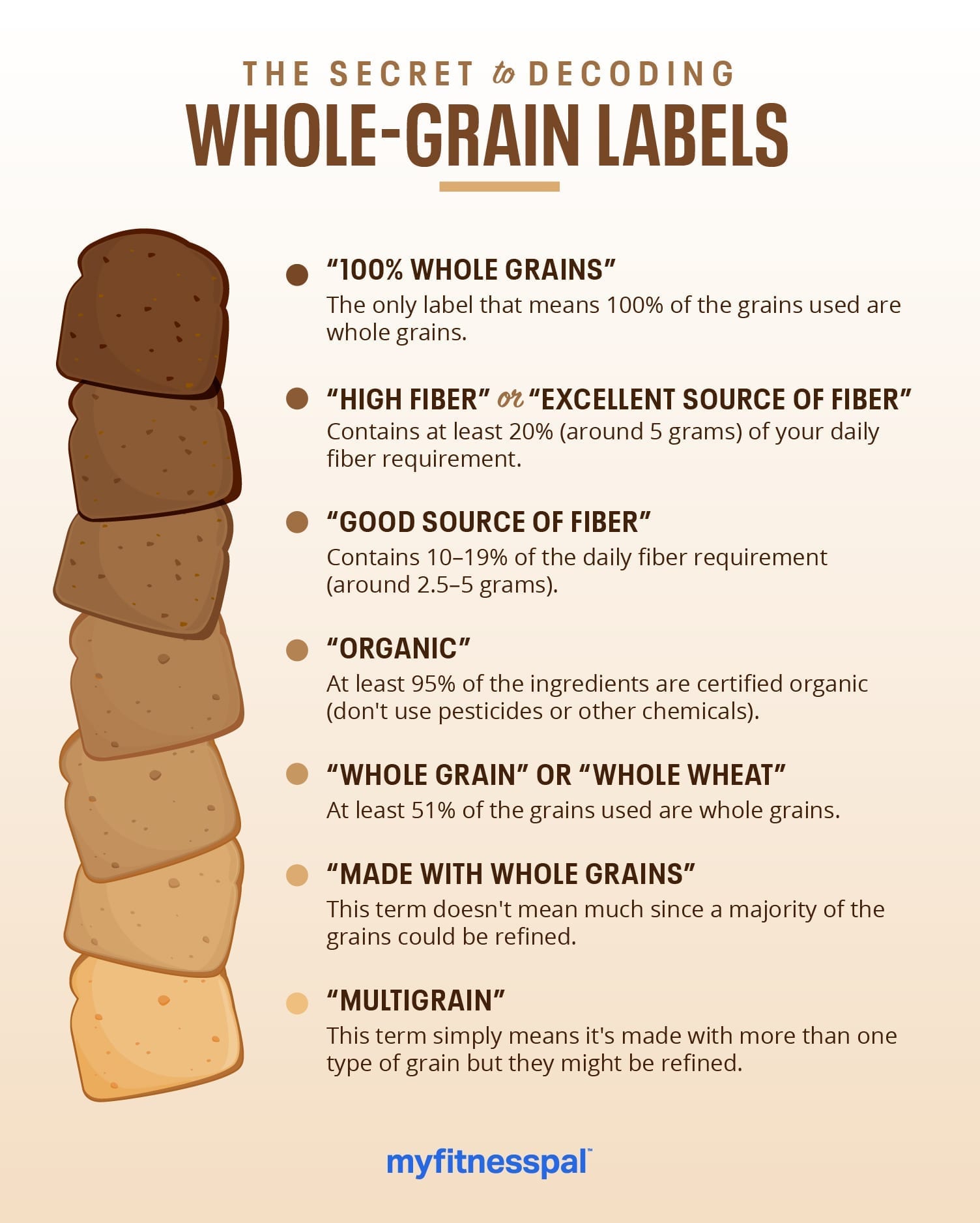If you feel confused when it comes toreading nutrition labels, you’re not alone.Added sugar can hide under 44 nicknames, and it can be tricky to decipherwhat cage-free and free-range mean on egg cartons. The same is true of carbohydrates like whole grains.Carbsare an essential nutrient thebody requires for energy, butnot all carbs are created equal. Whole grains are important because they give you the most nutrient bang for your carbohydrate buck, says Vicki Shanta Retelny, RD. Unlike refined grains, whole grains contain the entire grain kernel — the endosperm, bran and germ. Refined grains, on the other hand, have been processed to remove the bran and germ, which removes dietary fiber, iron and other nutrients.
In addition tofiber— which helps keep your digestive system moving, feeds healthy bacteria in your gut, and can help lower cholesterol — variouswhole grains(Think: quinoa, barley, oats and farro) contain different combinations of zinc, manganese, folate, magnesium, copper, thiamin, niacin, vitamin B6, phosphorus, selenium, riboflavin and vitamin A.
Even if you know whole grains are a healthy choice and actively seek them out, it can be hard to tell which products actually contain whole grains and which are just pretending they do. Before your next trip to the grocery store, read up on how to decode the following terms on whole-grain labels:

“100% WHOLE GRAINS”
If you’re looking for a product that’s made only with whole grains, look for the “100% whole grains” label. According to theFood and Drug Administration(FDA), the agency thatregulates food labels, this is the only label that means all of the grains in that product come from whole grains. However, it doesn’t mean whole grains are the only ingredient. The product could also contain non-grain ingredients like sweeteners, salt, added oils, preservatives and flavorings.
This isn’t necessarily a bad thing, but if you’re choosing the “100% whole grain” label because you want to make a nutritious choice, a whole grain should be the first ingredient listed. There should not be a ton ofadded sugarorsaturated faton the nutrition label. For example, when choosing bread, look for “100% whole grain,” with at least 2–3 grams of fiber and 3–4 grams of protein per serving. There should be no added sugar, such ashigh-fructose corn syrup, recommends Kelly Hogan, RD.
“HIGH FIBER” OR “EXCELLENT SOURCE OF FIBER”
A product labeled “high fiber” or “excellent source of fiber” contains at least 20% (about 5 grams) of your daily fiber requirement. Grain products with this label likely contain mostly whole grains, but you can still check for the “100% whole grain” label as well.
“GOOD SOURCE OF FIBER”
This label signifies one serving of the product contains 10–19% of the average adult’s daily fiber needs, or roughly 2.5–5 grams per serving, according to theAmerican Heart Association(AHA). That’s a good thing, since fiber has many health benefits, but it doesn’t necessarily mean the product contains mostly whole grains. Look for the “100% whole grain” label in addition to this one.
“ORGANIC”
The “organic” label is regulated by theUnited States Department of Agriculture(USDA), and means at least 95% of the ingredients in a product are certified organic — produced in line with standards that forbid the use of certain pesticides and other substances, and require certain sustainable and environmentally-friendly practices. While organically grown ingredients and organically raised meats are generally good for sustainability,they’re not necessarily healthier. Moreover, just because a grain product is organic doesn’t necessarily mean it’s whole grain, which is why you would need to also look for the “100% whole grain” label.
“WHOLE GRAIN” OR “WHOLE WHEAT”
If a product is just labeled “whole grain” or “whole wheat,” it’s made up of at least 51% whole grains by weight. The remaining 49% contains some amount of refined grains, plus other ingredients like sweeteners, salt, added oils, preservatives or flavorings. If the product is labeled “whole wheat,” that 51% comes from wheat; if the product is labeled “whole grain,” it might come from any type of whole grain, or a combination of different whole grains.
Although “whole-grain” products do contain some refined grains and generally aren’t as nutritious as “100% whole-grain” products, they aren’t necessarily a bad choice. They still contain significant amounts of whole grains and the nutrients these grains provide.
“MADE WITH WHOLE GRAINS”
This is a meaningless term when it comes to the nutrition profile of a product and is a marketing ploy. Technically a product containing a tiny amount of whole grains is “made with whole grains,” but that could still mean the majority of the product is made with refined grains or other ingredients. There’s nothing wrong with eating refined grains sometimes — remembereverything in moderationcan be part of a healthy, well-balanced diet — but if you’re seeking out a whole-grain product for extra nutrients, this isn’t the label to seek.
“MULTIGRAIN”
This label can be deceiving because it simply means a product is made with more than one type of grain. It doesn’t mean all of these grains are whole grains. In fact, it may be the case thatnoneare whole grains. The same goes for labels like “10-grain” bread or “made with 15 grains and seeds.” Just because these ingredients are in the product, doesn’t mean they’re whole grains or the main ingredients.
THE BOTTOM LINE
If you’re looking to up your whole-grain consumption, buying “100% whole-grain” products is the only way to know you’re getting all whole grains and no refined ones. “High fiber” and “good fiber” labels can also help youincrease your fiber intake, while the “organic” label might be important to you if sustainability is something you value. The “whole grain,” “whole wheat,” “made with whole grains” and “multigrain” labels all include some refined grains.
Unlock an experience that’s like having a dietitian, trainer and coach — right at your fingertips.Go Premiumfor expert guidance and exclusive tools that will help you reach your personal health goals.
